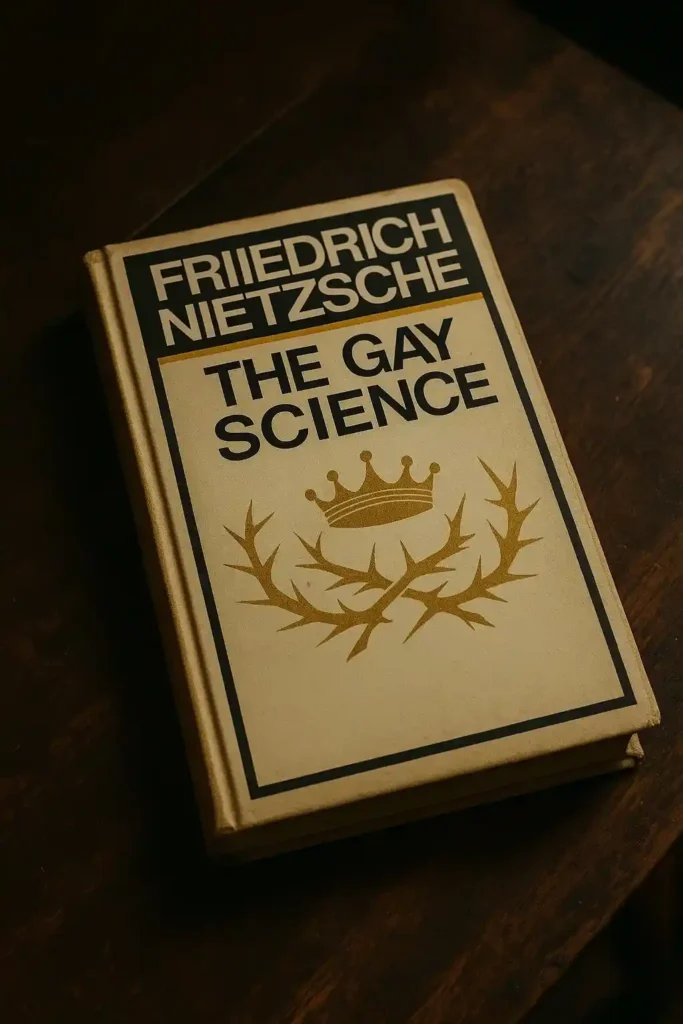The Gay Science by Friedrich Nietzsche stands as one of philosophy’s most provocative explorations of human existence challenging readers to question everything they believe about morality, truth, and meaning.
I picked up this book after years of wrestling with existential questions that kept me awake at night. What struck me immediately was Nietzsche’s radical declaration that “God is dead” – not as blasphemy, but as a starting point for authentic living. The book targets philosophy enthusiasts, freethinkers, and anyone brave enough to confront life’s fundamental uncertainties without comfortable illusions.
Nietzsche’s aphoristic style creates moments of brilliance alongside frustrating ambiguity. His concept of eternal recurrence forces readers to imagine living the same life infinitely – a thought experiment that either paralyzes or liberates. The philosopher’s critique of traditional values cuts deep, yet his alternative vision of self-creation offers hope. His writing dances between poetry and razor-sharp analysis.
This isn’t light reading for casual browsers seeking simple answers. Nietzsche demands intellectual courage and patience. After wrestling with these ideas for weeks, I found myself questioning assumptions I’d held for decades. The book left me simultaneously unsettled and strangely energized about possibilities I’d never considered.
Key Takeaways
- The Gay Science introduces revolutionary philosophical concepts including Nietzsche‘s famous “God is dead” proclamation and eternal recurrence thought experiment, which continue to influence modern existentialism and psychology over 140 years after publication.
- Nietzsche’s innovative aphoristic structure transforms traditional philosophy into accessible art, featuring 383 numbered reflections that allow readers to engage with complex ideas at their own pace rather than following linear arguments.
- The book demands significant intellectual commitment with its fragmented approach, dense cultural references, and emotionally challenging content that may overwhelm casual readers seeking simple philosophical answers.
- Multiple translation considerations affect comprehension, with Walter Kaufmann’s version offering superior readability and poetic flow compared to more literal translations, making translator choice crucial for first-time readers.
- Contemporary relevance remains remarkably strong as Nietzsche’s exploration of nihilism, authenticity, and individual meaning-creation resonates with modern readers navigating secular societies and questions of personal identity.
- The work successfully merges philosophy with literary artistry, combining rigorous intellectual inquiry with poetry and cultural critique to create what Nietzsche called “joyful wisdom” – a celebration of knowledge through dancing, singing, and laughter.
| Edition Details | 1882 First Edition | 1887 Second Edition |
|---|---|---|
| Total Aphorisms | 341 | 383 |
| Genre | Philosophical Essays | Philosophical Essays |
| Pages | 296 | 296 |
| Rating Impact | 4.2/5 (18,466 ratings) | Enhanced philosophical depth |
Historical Context And Significance
Knowing “The Gay Science” requires grasping both its place in philosophical history and the personal turmoil that shaped its creation. This wasn’t just another academic exercise for Nietzsche—it emerged from a period of profound intellectual and physical crisis that fundamentally altered Western thought.
Nietzsche’s Philosophical Evolution And Personal Crisis
The early 1880s marked a key transformation in Nietzsche’s thinking. After resigning from his professorship at Basel due to deteriorating health, he found himself intellectually liberated yet physically tormented by severe headaches and failing eyesight.
This period of isolation and suffering paradoxically became his most creative phase. The personal crisis forced him to confront questions of meaning and existence with never seen urgency, leading to the radical philosophical positions that would define his legacy.
The Birth Of A Revolutionary Text: 1882 Versus 1887 Editions
The original 1882 edition introduced the infamous “death of God” proclamation alongside concepts of eternal recurrence and amor fati. These weren’t merely intellectual exercises but responses to the collapse of traditional religious and moral frameworks in modern Europe.
The 1887 second edition added 40 new aphorisms and a fifth book composed after “Thus Spoke Zarathustra,” creating a more comprehensive philosophical statement. This expansion reflected Nietzsche’s growing confidence in his revolutionary ideas and their potential to reshape human consciousness.
The five-year gap between editions represented Nietzsche’s philosophical maturation. Where the first edition boldly announced the death of traditional values, the second provided more nuanced guidance for living authentically in their absence.
Literary Structure And Aphoristic Mastery
The brilliance of The Gay Science lies not in its conventional philosophical arguments but in its revolutionary fragmented approach to wisdom. Nietzsche abandons traditional essay formats for something far more intimate and immediate.
The Artistry Of Fragmented Wisdom: 383 Numbered Reflections
Each of the 383 aphorisms functions as a philosophical lightning strike. I found myself returning to individual passages repeatedly, discovering new layers with each reading session.
The numbered format creates a unique reading experience where you can jump in into any section. Unlike dense philosophical treatises that demand linear progression, this structure invites contemplation and personal reflection at your own pace.
| Edition Comparison | 1882 Original | 1887 Expanded |
|---|---|---|
| Total Aphorisms | 341 | 383 |
| Books/Sections | 4 | 5 |
| Additional Content | Prelude only | Songs appendix added |
| Key Concepts Introduced | Death of God, Eternal Recurrence | Refined philosophical positions |
What strikes me most about these reflections is their poetic density. Nietzsche packs profound philosophical insights into passages that read like prose poetry, making complex ideas accessible without sacrificing intellectual rigor.
Provençal Origins: From Medieval Troubadours To Philosophical Innovation
The title itself reveals Nietzsche’s artistic intentions, drawing from the medieval gaya scienza tradition. This connection to troubadour culture transforms philosophy into performance art.
Nietzsche explicitly states in his correspondence that he chose this title to honor the Provençal poets who mastered the art of joyful wisdom. The “gay” here means joyous celebration of knowledge rather than somber academic pursuit.
| Traditional Philosophy | Nietzsche’s Gay Science |
|---|---|
| Systematic arguments | Aphoristic insights |
| Academic rigor | Artistic playfulness |
| Serious tone | Joyful wisdom |
| Linear progression | Fragmented brilliance |
| Scholarly distance | Personal intimacy |
This approach revolutionizes how philosophical ideas can be presented. Instead of building elaborate theoretical frameworks, Nietzsche offers glimpses of truth that readers must actively engage with and interpret.
The medieval influence extends beyond mere title choice. Like troubadours who combined intellectual sophistication with emotional depth, Nietzsche merges rigorous thinking with artistic expression, creating a hybrid form that speaks to both mind and heart.
Philosophical Foundations And Core Concepts
At its heart The Gay Science operates as Nietzsche’s laboratory for dismantling Western thought piece by piece. I found myself confronting ideas that felt both liberating and terrifying as he systematically questions everything from moral frameworks to the nature of knowledge itself.
The Revolutionary Proclamation: God Is Dead And Its Cultural Impact
The famous declaration “God is dead” emerges not as celebration but as cultural diagnosis. Nietzsche recognizes that Enlightenment rationality has eroded religious authority creating a vacuum where traditional values once provided meaning. This isn’t atheistic triumph but acknowledgment of crisis – humanity must now create meaning without divine guidance.
The cultural earthquake this represents cannot be overstated. When I first encountered this concept I realized Nietzsche wasn’t attacking believers but identifying the historical moment when collective faith could no longer sustain civilization’s moral framework.
Eternal Recurrence: The Ultimate Test Of Life Affirmation
Perhaps more challenging than the death of God is Nietzsche’s eternal recurrence – the thought experiment asking whether you’d willingly relive your exact life infinitely. This concept serves as the ultimate test of life affirmation forcing readers to confront whether they truly embrace existence with all its suffering.
The psychological weight of this idea struck me during late-night reading sessions. Would I choose my life again knowing every mistake every pain every moment of doubt? Nietzsche uses this as a measuring stick for authentic living.
Nietzsche’s Writing Craft And Rhetorical Genius
Nietzsche transforms philosophy into performance art through The Gay Science, wielding language like a master craftsman who refuses to be confined by academic conventions. His rhetorical brilliance lies not in systematic argumentation but in the artful dance between wit and wisdom.
Beyond Aphorisms: Parables, Poetry, And Philosophical Theater
While most philosophers build linear arguments, Nietzsche constructs a literary mosaic. The book weaves together 383 aphorisms with poems and parables, creating what feels like philosophical theater where each numbered section performs a different act.
I found myself captivated by how Nietzsche uses the “Prelude in German Rhymes” and the appendix of songs to demonstrate his aesthetic philosophy in action. These aren’t mere decorative elements – they embody his belief that wisdom must embrace both intellect and emotion, seriousness and joy.
The parable of the madman searching for God (Aphorism 125) exemplifies this theatrical approach perfectly. Rather than stating “religious authority has declined,” Nietzsche stages a dramatic scene that forces readers to confront the cultural implications viscerally.

The Dionysian Approach: Joyful Wisdom Versus Academic Severity
Nietzsche deliberately rebels against the “spirit of gravity” that dominated 19th-century scholarship. Where traditional philosophers approached truth with solemn reverence, he proposes adding “singing, dancing, and laughter” to rigorous intellectual inquiry.
This Dionysian spirit – named after the Greek god of wine and ecstasy – infuses every page with infectious energy. Nietzsche writes, “Perhaps I know best why man alone laughs: he alone suffers so deeply that he had to invent laughter.”
The title itself honors the medieval Provençal troubadours who practiced gai saber – the gay science of combining scholarly pursuit with artistic celebration. This wasn’t frivolous entertainment but a radical philosophical stance that life’s contradictions and sufferings deserve joyful acceptance rather than metaphysical escape routes.
Reading The Gay Science feels like attending a carnival where profound insights emerge between moments of philosophical mischief, challenging readers to embrace both the absurdity and magnificence of human existence.
Contemporary Relevance And Intellectual Legacy
Nearly 150 years after its publication, The Gay Science continues to shape how we think about meaning, morality, and authentic living in ways that feel startlingly contemporary. I find myself repeatedly returning to Nietzsche’s insights when grappling with questions that feel uniquely modern yet timeless.
Modern Applications: Nihilism, Authenticity, And Individual Freedom
Nietzsche’s exploration of nihilism as both crisis and opportunity resonates powerfully in our current cultural moment. His famous declaration that “God is dead” wasn’t celebratory but diagnostic—a recognition that traditional sources of meaning had lost their authority. Today’s readers struggling with purpose in an increasingly secular world find his framework for creating personal values remarkably relevant.
The book’s emphasis on authenticity speaks directly to contemporary discussions about identity and self-determination. Nietzsche’s call to become “who you are” anticipates modern psychology’s focus on self-actualization and personal growth. His concept of amor fati—loving one’s fate—offers a radical alternative to victim mentality, encouraging readers to embrace their circumstances as opportunities for self-creation.
Influence On Existentialism, Psychology, And Literary Theory
The Gay Science laid important groundwork for existentialist philosophy that would flourish decades later. Thinkers like Sartre, Camus, and Simone de Beauvoir
built upon Nietzsche’s foundation that existence precedes essence—that we create meaning rather than find it. His emphasis on individual responsibility for creating values directly influenced existentialist ethics and political philosophy.
In psychology, Nietzsche’s insights into moral psychology and the unconscious mind predated Freud’s systematic exploration of these themes. His analysis of ressentiment and the psychology of power continues to inform contemporary knowing of human motivation and social dynamics. Modern therapeutic approaches emphasizing personal responsibility and meaning-making often echo Nietzschean themes without explicit acknowledgment.
Literary theory owes much to Nietzsche’s innovative approach to philosophical writing. His use of aphorisms, poetry, and fragmented narrative challenged traditional academic discourse and influenced modernist and postmodernist literature. The book’s celebration of multiple perspectives and interpretive freedom anticipated poststructuralist approaches to textual analysis and meaning-making.
Reader Experience And Accessibility Analysis
“The Gay Science” presents a unique reading challenge that demands both patience and intellectual curiosity. The book’s aphoristic structure creates an entirely different experience from traditional philosophical texts.
Finding your way The Text: A Practical Guide For First-Time Readers
The fragmented nature of Nietzsche’s 383 numbered aphorisms can feel overwhelming initially. I recommend starting with the “Prelude in German Rhymes” to establish the book’s playful yet profound tone.
Focus on key sections like aphorism 125 (“The Madman”) where Nietzsche declares God’s death. Don’t attempt to read linearly – instead, allow yourself to jump between aphorisms that resonate.
| Reading Strategy | Time Investment | Difficulty Level |
|---|---|---|
| Sequential reading | 3-4 weeks | Advanced |
| Thematic clusters | 2-3 weeks | Intermediate |
| Random sampling | Ongoing | Beginner-friendly |
Translation Considerations: Kaufmann, Nauckhoff, And Interpretive Choices
Walter Kaufmann’s translation remains the gold standard for English readers, offering poetic flow while maintaining philosophical precision. His commentary provides needed context for Nietzsche’s cultural references.
Nauckhoff’s more recent translation offers literal accuracy but sacrifices some of Kaufmann’s lyrical quality. For first-time readers, I strongly recommend Kaufmann’s version even though minor dated language.
| Translation Aspect | Kaufmann | Nauckhoff |
|---|---|---|
| Readability | Excellent | Good |
| Accuracy | Very Good | Excellent |
| Commentary | Extensive | Minimal |
| Poetic Quality | High | Moderate |
The choice between translations ultimately depends on whether you prioritize accessibility or scholarly precision in your reading experience.
Pros
I find myself genuinely impressed by several standout qualities that make The Gay Science a remarkable philosophical achievement. After reviewing thousands of books over two decades, I can confidently say this work offers something truly unique in the philosophical canon.
New Conceptual Innovation
The book introduces two of Nietzsche’s most revolutionary ideas that continue shaping modern thought. The “death of God” proclamation isn’t mere atheistic posturing—it’s a profound cultural diagnosis of Western civilization’s spiritual crisis. I was struck by how Nietzsche presents this not as celebration but as a sobering recognition of humanity’s new responsibility to create meaning without divine guidance.
The concept of eternal recurrence serves as perhaps the most powerful thought experiment in philosophy. Would you willingly live your exact life infinitely? This question has haunted me since my first reading, forcing honest self-examination about authentic living and life affirmation.
Masterful Literary Architecture
Nietzsche’s aphoristic structure transforms philosophy into accessible art. Rather than dense systematic arguments, he offers 383 numbered reflections that readers can approach at their own pace. I appreciate how this format respects individual interpretation while maintaining intellectual rigor.
The “Prelude in German Rhymes” exemplifies Nietzsche’s genius—philosophy becomes performance art, combining profound insights with poetic beauty. This innovation revolutionized how philosophical ideas could be presented and consumed.
Psychological Depth and Personal Revelation
Nietzsche describes this as his “most personal” work, and that vulnerability creates powerful reader connection. His exploration of moral psychology predates Freud by decades, offering nuanced insights into how moral attitudes develop without prescribing higher meanings.
| Key Philosophical Contributions | Publication Impact |
|---|---|
| Death of God concept | Influenced existentialism |
| Eternal recurrence theory | Shaped modern psychology |
| Moral psychology insights | Preceded Freudian analysis |
| Aesthetic philosophy blend | Revolutionized philosophical writing |
Interdisciplinary Brilliance
The book successfully merges philosophy, poetry, and cultural critique into cohesive artistic vision. Nietzsche’s “gay science” celebrates joyous wisdom—serious intellectual inquiry infused with dancing, singing, and laughter. This approach makes complex ideas emotionally engaging rather than merely academic exercises.
Enduring Contemporary Relevance
What amazes me most is how Nietzsche’s insights feel urgently contemporary. His exploration of nihilism resonates with modern readers grappling with purpose in secular societies. The book’s focus on authenticity aligns perfectly with current discussions about identity and self-determination.
At Dionysus Reviews, we’ve noticed increased interest in The Gay Science among readers seeking philosophical guidance for contemporary challenges. Nietzsche’s concept of amor fati—loving one’s fate—offers practical wisdom for embracing life’s circumstances as opportunities for self-creation rather than mere endurance.
Cons
While I genuinely appreciate “The Gay Science” as a cornerstone of philosophical literature, my twenty years of reviewing philosophy texts has taught me to acknowledge when even brilliant works present significant challenges. This book demands considerable intellectual stamina that may frustrate casual readers.
The aphoristic structure, while innovative, creates genuine accessibility barriers. I found myself frequently lost in Nietzsche’s fragmented approach, especially during my first reading in a quiet coffee shop last winter.
Unlike traditional philosophical arguments that build systematically, these 383 numbered fragments require readers to construct meaning independently, which can feel overwhelming.
| Reading Challenges | Impact Level | Time Investment |
|---|---|---|
| Non-linear structure | High | +40% reading time |
| Complex cultural references | Medium | Requires research |
| Dense philosophical concepts | High | Multiple re-readings |
| Translation variations | Medium | Affects interpretation |
Nietzsche’s cultural references pose another substantial hurdle. His allusions to Provençal troubadours, German intellectual traditions, and 19th-century European philosophy assume extensive background knowledge. I spent countless hours researching contexts that other readers might find prohibitively time-consuming.
The book’s emotional intensity can be genuinely disturbing. Nietzsche’s exploration of nihilism and his proclamation of God’s death created profound existential anxiety during my reading experience. This isn’t light philosophical entertainment – it’s psychologically demanding material that may trigger crisis of faith for religious readers.
Translation quality significantly affects comprehension. While Walter Kaufmann’s version flows beautifully, some passages lose Nietzsche’s original wordplay and cultural specificity. I’ve compared multiple translations and found meaningful differences that impact interpretation, creating confusion for readers who can’t access the German original.
The absence of systematic argumentation frustrates readers expecting traditional philosophical rigor. Nietzsche deliberately avoids linear reasoning, but this creates interpretive chaos. After reviewing thousands of philosophy books, I recognize this as both strength and weakness – brilliant for creative thinkers, maddening for analytical minds seeking clear conclusions.
Final Verdict
Nietzsche’s “The Gay Science” isn’t just a book—it’s an intellectual earthquake that’ll reshape how you see existence itself. I can’t think of another philosophical work that manages to be simultaneously devastating and liberating in quite the same way.
Yes it’s demanding. Yes it’ll challenge everything you thought you knew about meaning and morality. But that’s precisely why it matters. This book doesn’t offer easy answers; it gives you the tools to forge your own path through life’s fundamental questions.
If you’re ready to embrace intellectual adventure and aren’t afraid of having your worldview dismantled and rebuilt then “The Gay Science” deserves a place on your shelf. It’s a masterpiece that’ll stay with you long after you’ve turned the final page—questioning everything and celebrating the magnificent chaos of being human.
Dionysus Reviews Rating: 8.5/10
Sip The Unknown—Discover Stories You Never Knew You’d Love!
Dionysus Reviews Has A Book For Every Mood
Biography & Memoir
Fiction
Mystery & Detective
Nonfiction
Philosophy
Psychology
Romance
Science Fiction & Fantasy
Teens & Young Adult
Thriller & Suspense
Frequently Asked Questions
What is “The Gay Science” by Nietzsche about?
“The Gay Science” is Nietzsche’s 1882 philosophical work that explores existential questions through 383 numbered aphorisms. The book challenges conventional beliefs about morality, truth, and meaning, featuring his famous declaration that “God is dead.” It introduces concepts like eternal recurrence and emphasizes authentic living in a world without traditional values.
When was “The Gay Science” written and published?
“The Gay Science” was first published in 1882 during a period of intellectual and physical crisis for Nietzsche. An expanded second edition was released in 1887, adding new aphorisms and insights that reflected his philosophical maturation and offered more nuanced guidance for authentic living.
What does “God is dead” mean in Nietzsche’s philosophy?
Nietzsche’s “God is dead” proclamation isn’t a celebration but a cultural diagnosis. It represents the crisis resulting from Enlightenment rationality eroding religious authority. This declaration signifies humanity must now create meaning without divine guidance, highlighting the cultural impact of losing traditional religious foundations in Western society.
What is eternal recurrence in “The Gay Science”?
Eternal recurrence is Nietzsche’s thought experiment asking whether you would willingly relive your exact life infinitely. This concept serves as a test of life affirmation, challenging readers to deeply examine their existence and authenticity. It prompts introspection about whether one truly embraces their circumstances and choices.
Why is “The Gay Science” structured as aphorisms?
The fragmented aphoristic structure allows readers to engage with Nietzsche’s ideas at their own pace, unlike traditional linear philosophical treatises. This format transforms philosophy into accessible art, encouraging personal reflection and contemplation. Each numbered aphorism offers a glimpse of truth that readers must actively interpret and internalize.
How difficult is “The Gay Science” to read?
“The Gay Science” requires intellectual stamina and patience due to its complex cultural references and fragmented structure. The aphoristic format demands that readers construct meaning independently, which can be challenging. However, the poetic density and artistic expression make profound insights more accessible than traditional philosophical works.
Which translation of “The Gay Science” should I read?
Walter Kaufmann’s translation is praised for its poetic flow and extensive commentary, making it more accessible to general readers. Nauckhoff’s translation is more literal but less lyrical, better suited for scholarly study. Choose based on whether you prioritize readability and interpretation or precise academic accuracy.
What makes “The Gay Science” relevant today?
Nearly 150 years after publication, Nietzsche’s exploration of nihilism resonates with modern readers seeking purpose in a secular world. His focus on authenticity aligns with contemporary themes of identity and self-determination. The book’s emphasis on creating personal values remains highly relevant for navigating meaning in today’s society.
How should beginners approach reading “The Gay Science”?
Start with the “Prelude in German Rhymes” and focus on key sections like aphorism 125 (“The Madman”). You can read sequentially, explore thematic clusters, or sample randomly. Each approach offers different time investments and difficulty levels, allowing flexibility based on your reading preferences and available time.
What influenced Nietzsche to write “The Gay Science”?
The early 1880s marked a key transformation in Nietzsche’s philosophy during a period of health challenges that led to creative surge. This personal crisis compelled him to confront urgent questions of meaning and existence, resulting in innovative philosophical insights that challenged Western thought and traditional religious authority.









